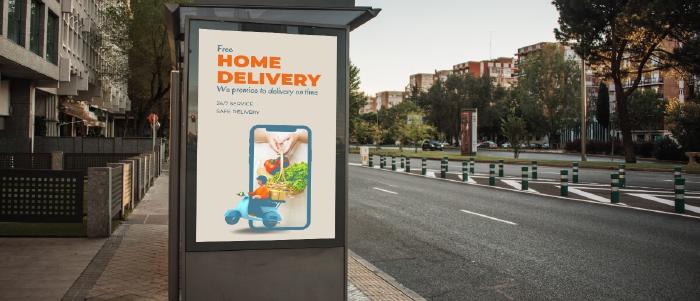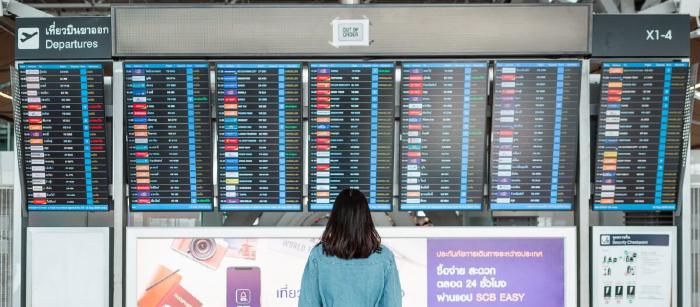
Sep 21 2023
7 min read


Billions of people commute daily for various reasons within a city, to other cities, or across the globe. The transportation industry requires a vast network to manage the humongous crowd. Since digital signage originated, the transportation industry has willingly adopted the technology.
Railways, busways, and airways— all transportation hubs extensively use digital signs for information dissemination, crowd management, passenger entertainment, revenue generation, and whatnot.
The Covid-19 pandemic has expedited the adoption of advanced digital signage solutions for transportation by necessitating contactless check-ins and self-service.
However, beyond safety and hygiene, there are multiple advantages of using digital signage for public transportation. Let’s explore them one by one.
Here are the five most prominent benefits of using digital signage for public transportation:
The most significant advantage of digital signage technology is that it can bring live information to the screens with the help of advanced integrations. For instance, digital signage platforms like Pickcel can be integrated with various transportation management systems like:
ticketing systems
queue management systems
intelligent vehicle tracking systems, GPS,
staff scheduling systems, and more.
This allows digital screens to show up-to-the-moment information like bus, train, or flight schedules, arrival/departure times, gate numbers, vehicle ETAs, etc.
We must have all seen flight information display systems (FIDS) showing this real-time information to the passengers. Such passenger information systems are nowadays a common sight on railway stations, bus-stops & subways; these are nothing but digital signage running real-time data.
These displays have made passengers self-reliant and largely reduced the volume of queries at the counters.
Pickcel designed an intelligent Passenger Information System (PIS) for two award-winning Bus-Rapid-Transit-Systems in India. Read the story
Most public transportation hubs are quite massive area-wise. Older people or less frequent travelers often need help navigating through unfamiliar layouts. But since most transportation hubs are adopting digital signage technology, wayfinding has become more accessible.
Digital wayfinding signage are now commonly seen at airports and railway stations; many of these display systems are interactive and enable passengers to browse on-demand information such as:
the digital layout of the premise,
virtual tours,
nearest elevators, cafes, restrooms
available parking spots, disability-friendly parking spots
wheelchair assistance & other helpline numbers, etc.
It is often mandatory for public transportation hubs to show critical information in all the official languages of a country.Often multilingual information is displayed on outdoor digital signage to ensure that language barriers never cause any disruption.
Japan’s Takanawa Gateway Station is one great example. To prepare for the labor shortage, the East Japan Railway Co. has deployed AI-equipped experimental robots that relay audio-visual outputs about the station, nearby places, fares, ticketing, etc.
These robots are fitted with digital signage that can show the information in Japanese, English, Chinese, and Korean. Take a look at this video:
Beyond language accessibility, many public transportation hubs are stepping up to become disability-friendly. Digital displays now have braille or visually-impaired passengers showing the floor map and directions to specific places like baggage collection or pick-up points. This is just the tip of the iceberg; there is much more to creating an environment of accessibility using digital signage.
Digital signage doesn’t have to display only transport and travel-related information. These can display various advertisements and promotional videos as well. Ad space renting can be an excellent supplementary source of income for transportation hubs.
The digital signage advertising networks at transportation centers can also promote small-scale local businesses like tourist lodges, eateries, and recreational industries.
Besides, ads & entertainment content also help reduce commuters’ perceived wait time. Live news updates, sports match highlights, event narrowcasting, weather predictions, and music video streaming - all make the harrowing wait-time more bearable.
The Pickcel screen content management system offers a wide range of content apps like live weather, AQI, news apps, live streaming apps, and more. Make sure to check out the Pickcel app store.
Digital signage can also be used to alert passengers about any emergency. They can be informed about general safety rules. In case of any mishap, evacuation routes are also displayed for the passengers.
It is quite natural for the public to panic in case of an emergency; safety information through digital signage can guide the passengers and restore order in the chaos.
One advanced scenario could be this: the digital signage software can be programmed to recognize various sensor-delivered triggers (for example, vibrations during earthquakes, sound of gunshots, etc.) and automatically update all the screens with emergency information, overriding any other screen content.
We are rapidly progressing to a future of smart ecosystems. Digital signage software solutions, through their ability to integrate with various other systems, have the potential to transform the transportation experience, making the future of travel safer, more accessible, and more profitable.
If you are looking for an advanced screen management solution, Pickcel’s years of innovation can bring you incredible RoIs. Schedule a demo with our experts today or start a free trial to get your business flying.

Sep 21 2023
7 min read

Oct 18 2022
13 min read

May 23 2022
7 min read

Dec 21 2023
8 min read
Take complete control of what you show on your digital signage & how you show it.
Start Free Trial Schedule My Demo